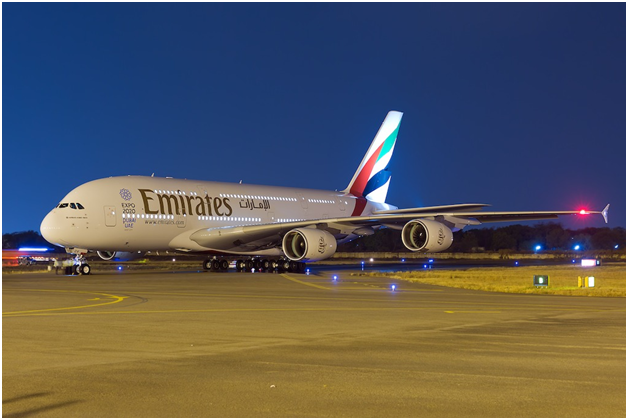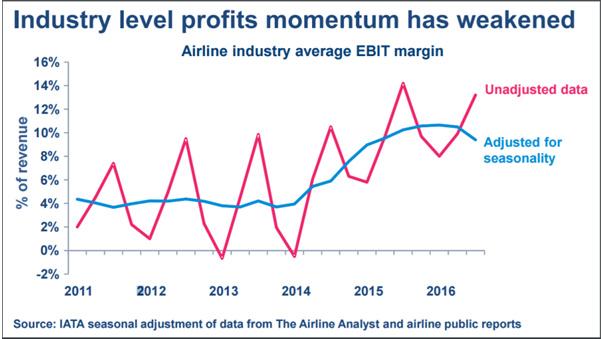Leeham News and Analysis
There's more to real news than a news release.
Fuel prices going forward
By Bjorn Fehrm

Source: Google images.
January 16, 2017, ©. Leeham Co: Oil has now doubled in price since the lowest point a year ago, with a present level of $50-$60/barrel. What is the trend going forward?
We are at the Growth Frontiers 2017 conference in Dublin, where Paul Horsnell, Head of Commodities research at Standard Chartered and Mike Corley, Mercatus Energy Adviser, gave their view on the future of oil prices.
The air transport market has seen a worldwide passenger and profitability growth over the last 12 months. The driving factors are increased appetite for air travel, especially in Asia, and cheap fuel.
Is Emirates in trouble?
Introduction
Jan. 12, 2017, © Leeham Co.: There are a growing number of articles around the Emirates airline that points to recent weaknesses in the airline’s operating model. Here are just two:
- “Is Emirates Airline running out of sky” asks Bloomberg?
- Is the Emirates Airline Growth Story at An End? writes Forbes.
We decided it was time for a deeper look at this locomotive from the Arab Emirates. Is Emirates in trouble? How solid is it?
 We studied the economics for the last decade and took a deep look at the fleet needs, including, has Emirates committed to too many aircraft being delivered over the next several years?
We studied the economics for the last decade and took a deep look at the fleet needs, including, has Emirates committed to too many aircraft being delivered over the next several years?
They have just deferred Airbus A380’s for the first time. Used to be they could not get them fast enough?
Summary:
- Emirates has been profitable since start 1985.
- Its unprecedented growth in revenue and passengers has slowed down.
- The low fuel price has kept profits up for now, but yield and load factors are down.
- With a flexible fleet structure and a strong balance sheet Emirates has a strong position to weather any storm going forward.
2017, a tougher year for European airlines?
By Bjorn Fehrm
January 5, 2017, ©. Leeham Co: The last two years have seen increased profits for the airline industry. Lower priced fuel gave the industry time to breath and to finally earn a reasonable Return on Invested Capital (ROIC).
Earnings as a percent of revenue for the industry has been increasing from 5% on a worldwide basis in 2014 to around 10% for 2016, Figure 1.
The US and European airlines have been topping the earnings with 18% on revenue for the third quarter of 2016. There are many signs this will not continue in 2017, especially for European airlines. Read more
Analyzing the Top Customers for Airbus and Boeing
Subscription Required
Introduction
Jan. 4, 2017, © Leeham Co.: The top 25 Airbus customers that are identified account for 63% for the current backlog, an analysis of the company’s order list shows.
For Boeing, its Top 25 customers account for 69% of its identified backlog.
Both companies have hundreds of Unidentified orders for which no customer is disclosed.
Summary
- “China Inc.” is Boeing’s #1 identified customer and #3 for Airbus.
- Two low cost carriers are the first and second top customer for Airbus.
- Three low cost carriers follow “China Inc.” as Boeing’s Top Customers.
- Boeing’s Top 3 wide-body customers are in the Middle East, where financial and traffic results are beginning to soften.
- Three of Airbus’ Top 5 customers are also from the Middle East. The other two are from Asia.
- Boeing has 54% of the market share among the Top wide-body customers. Airbus has a 54% market share in the narrow-body sector.
Market, other factors emerging, creating Boeing 787 concern
Subscription Required
Introduction
Jan. 4, 2017, © Leeham Co.: Despite a rosy picture painted by Boeing about the future of the 787 and the ability to recover more than $29bn in deferred production

Boeing photo.
and tooling costs, there are signs that cause concerns over the next 3-5 years.
Summary
- Near-term production outlook solid, weakness begins in 2020, big gap in 2021.
- Boeing doesn’t see wide-body sales recovery until next decade.
- Company foregoes increasing 787 accounting block; sales won’t support it.
- Market talks about deferring 787s.
Airbus, Boeing Top Customers mix of stable, risk and reward
Subscription Required
Introduction
Dec. 22, 2016, © Leeham Co.: When it comes to comparing backlogs of Airbus and Boeing, the latter likes to point to what it calls a better quality of customers.
The fact is, both companies have large orders with airlines that may be characterized as less than top quality, or which appear to have over-ordered.
Summary
- Airbus is more risk-reward oriented than Boeing.
- Airbus appears more aggressive in emerging markets.
- Airbus and Boeing share risky and quality customers.
- Many of the shared top customers are roughly balanced between Airbus and Boeing.
Pontifications: More job cuts coming at Airbus, Boeing
Dec. 12, 2016, © Leeham Co.: Airbus and Boeing continue to cut costs with internal reorganizations.
These are needed efforts. And they trickle down to the supply chain.
The new CEO at Boeing Commercial Airplanes, Kevin McAllister, is expected to ratchet up the cost-cutting at BCA, in part because he comes from the cost-cutting environment of GE Aviation.
He’s got a lot of work to do.
It takes Airbus Commercial about 85 employees to produce one airplane. It takes Boeing about 107.
Iran, Boeing reach agreement on big aircraft order; Trump casts cloud

No 747s are included in the final deal between Boeing and Iran. The original announcement included four 747-8s to replace aging 747s. Photo via Google images.
Dec. 11, 2016: Iran and Boeing reached an agreement on the 80-airplane order that includes 50 737 MAX 8s, 15 777-300ERs and 15 777-9s.
The final contract still has unspecified contingencies before it can be booked as firm orders, Boeing said. One of those contingencies is clearly President-Elect Donald Trump, who criticized the larger Iran-US-allies deal of which the Boeing order is a part.
Airbus has 116 orders pending that could also be upended if Trump, upon taking office, vitiates the deal.
Boeing’s mix of aircraft changed slightly from the original news in June. The original mix included 40 737 MAXes and six 737NGs. Also included then were four 747-8s.





Deferrals grow as airlines fight to keep bottom line
Subscription Required
Introduction
Jan. 09, 2017, © Leeham Co.: Airlines have deferred or are thinking about deferring more than 400 airplanes in the near term, a review of decisions and deliberations that have been made during the last 12 months.
LNC tracked announcements last year of deferrals and statements by airlines that they are thinking about doing so.
We began identifying macro-level issues last week in our posts about emerging concerns for the 787 and LNC’s Outlook for 2017.
Reasons vary widely for the deferrals, these reports indicated. Low oil prices. Slowing economies. Declining financial results. Worries about two of the three top Middle Eastern carriers. A capital squeeze in China. Pressure on long-haul carriers from the emerging sector of low cost, long-haul airlines. Preserving capital expenditures to keep the bottom line in the black.
Today we detail the deferrals we tracked.
Summary
Read more
1 Comment
Posted on January 9, 2017 by Scott Hamilton
Airbus, Airlines, Boeing, Bombardier, Delta Air Lines, Leeham News and Comment, Pratt & Whitney, Premium, Qatar Airways, Rolls-Royce
777 Classic, 787, A380, Airbus, airlines, Boeing, Bombardier, Emirates Airlines, Goldman Sachs, Qatar Airways